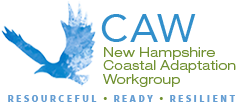By Kirsten Howard | NHDES Coastal Program Resilience Coordinator
I had the pleasure of attending the American Institute of Architects’ New England Chapter Annual Conference in Portsmouth in October. This one-day meeting challenged participants to figure out what it means to design for resilience. They asked questions like “How do we foster a resilient community through architectural design?” They advanced the conversation surrounding resilience beyond its conventional definition of bouncing back. Since “resilience” is pretty much my favorite word, I thoroughly enjoyed the event. Having essentially no background in architecture aside from the one modern architecture class I took in college (Gaudi? Frank Lloyd Wright? That’s all I’ve got.), I could take up a lot of your time explaining what I learned, but instead I’ll keep it short. Here are five tidbits.
“All disasters do is pull the covers off the problems we already have. That’s all they do.”
1
The architects I spoke with at the conference are savvy and enthusiastic when it comes to talking about designing for resilience.
But they also see limits to their influence and impact—they can’t design and build our communities to be resilient on their own. Architects brought up the tension they encounter between designing what they want to design (a beautifully resilient, engaging, storm and sea-level rise safe, and community-focused building) versus what their client wants them to build within the budget. That’s why we kept coming back to two things: 1) teachable moments (participants recognized they could arm themselves with some info provided about risk and share that with clients) and 2) building codes (those sometimes pesky regulations can actually be a good way of ensuring developers stick to best practices—if the codes are good).
2
Speakers emphasized that designing a process to build social capital and trust among community members is probably more important than designing and building a flood-proof building.
Someone referred to the fact that the key to resilience lies in how well people know their neighbors—and we discussed how to tackle “the loneliness epidemic” through building design and creative community-building public input sessions. That’s why I liked the vibe that panel moderator Emily Grandstaff-Rice (an architect with Arrowstreet) set when she opened by asking each of the panelists what they would be doing with their Saturday if they weren’t there at the conference. The experts got to share a little bit of themselves with the audience. We learned who had kids, pets, and side jobs, and afterwards everyone felt a little closer in their own little architecture-savvy community.
3
Boston’s Chief Resilience Officer Dr. Atyia Martin is helping her City to confront and address systemic racism as it attempts to plan for climate change.
Boston is so lucky to have her. I won’t attempt to recreate her talk on social justice. You should probably try to go see her speak. But, I will give you a teaser: she challenged us to think about how climate change and racism are quite similar—for example, they’re complicated, they’re legacies deeply based in decisions we’ve made throughout history, and there’s a lot that people don’t believe about them. She challenged us to be conscious of our implicit biases when we engage with community members and to make a real attempt to understand the history and issues in a neighborhood before coming up with “solutions.” To do this well, we need to commit to developing relationships with people who might look different from us. She develops relationships in lots of ways, but one tactic that stuck with me is that she just gets on the T, meets people, and listens to them. So simple. She encouraged us to challenge power by asking questions that would otherwise go unasked, and to diversify our social and professional networks. Check out the City’s Office of Resilience and Racial Equity and the Resilient Boston Strategy, the first resilience strategy in the nation to incorporate equity as a guiding principle.
4
Taking a break for lunch and some quality fresh air time is always more important than I think it will be.
We were encouraged to eat lunch outside. A group of us loaded our plates and found a small little park where we sat down on the grass and talked… you guessed it… resilience. How often does that happen at a conference??
AND, 5
The military prison at the Navy Shipyard is absolutely as spooky and cool up close as I hoped it would be.
We went on a guided tour of the Portsmouth Naval Shipyard to learn how they plan for resilience. That community is definitely thinking about its own low-lying, island challenges. While we didn’t uncover or stumble upon any classified information, it’s fun to pretend that we know more than we’re allowed to share (shhh!).
To learn more about AIA’s resilience initiatives, follow @AIA_Resilience on Twitter.
